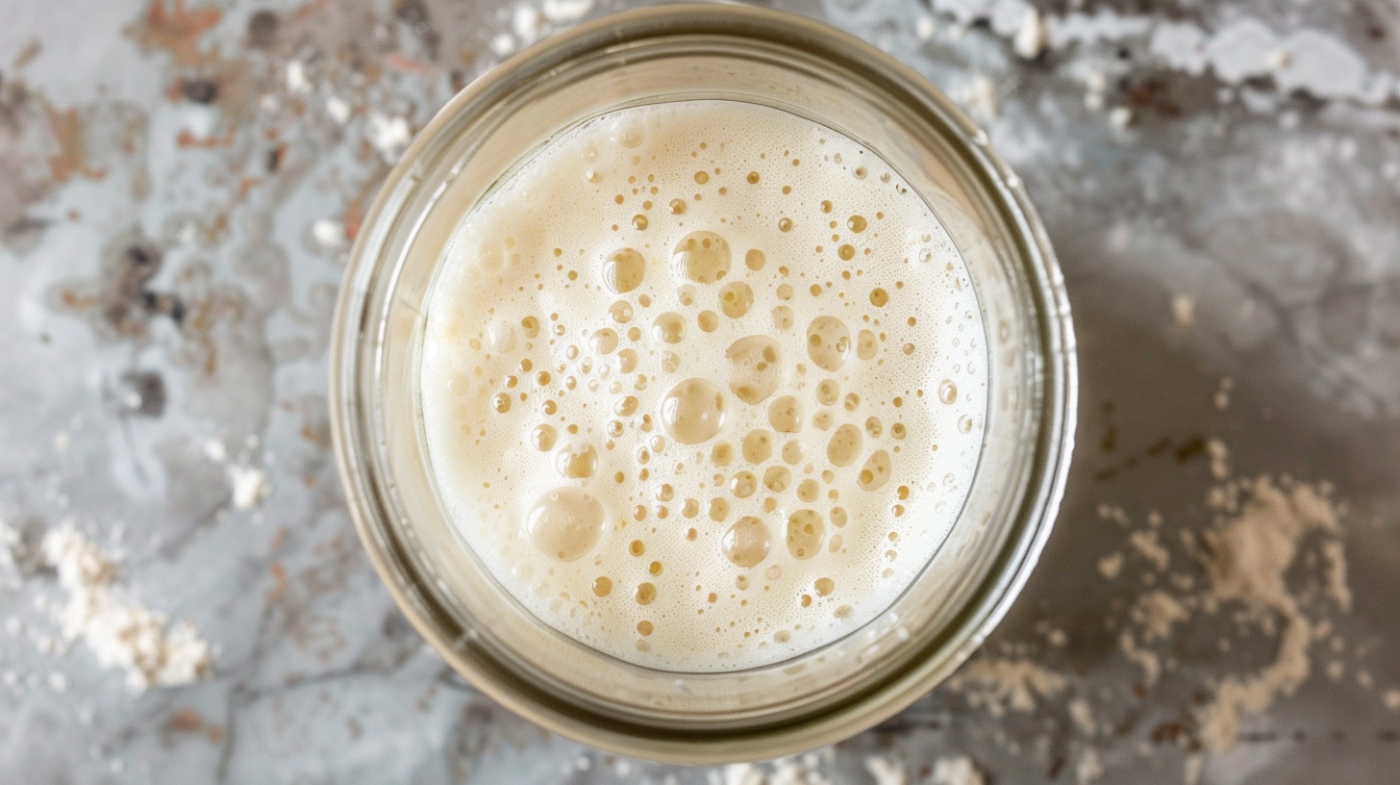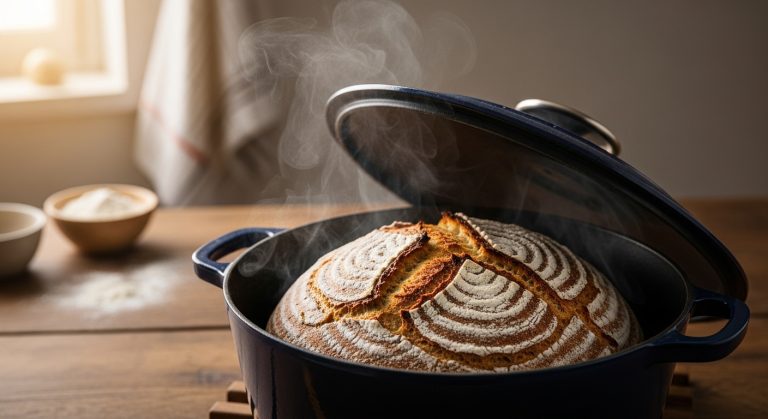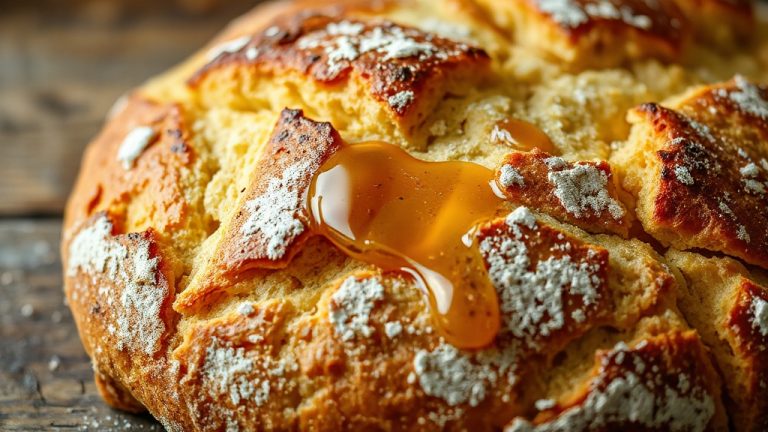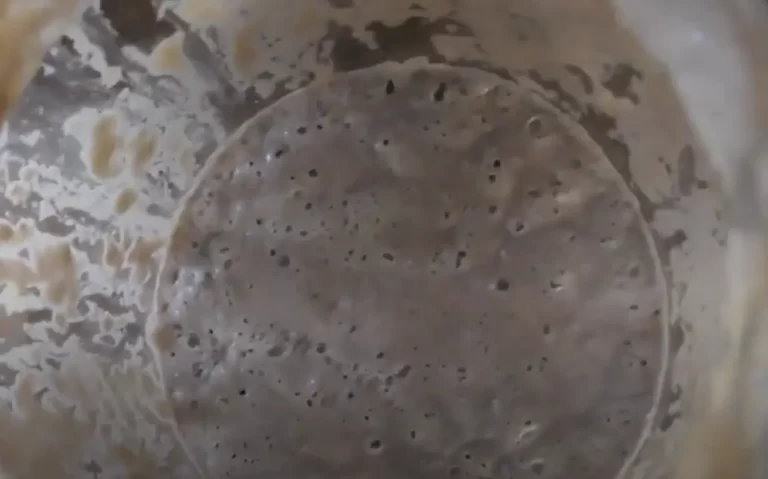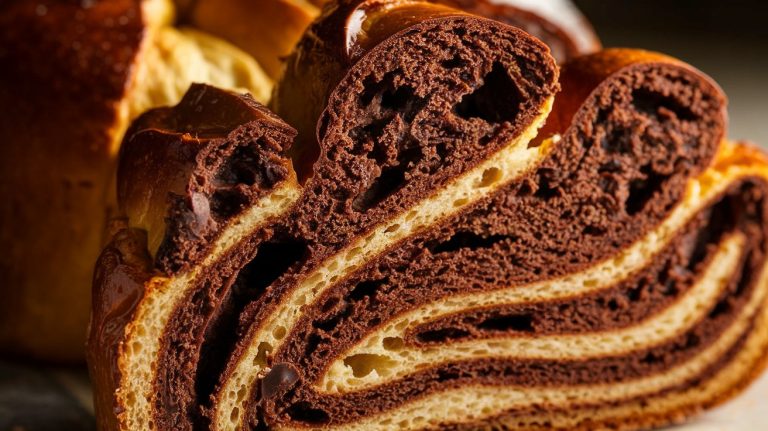Why Is My Sourdough Starter Runny: Adjustments for Success
Your sourdough starter may be runny due to several factors. Unbalanced feeding ratios, like using too much water compared to flour, can lead to over-hydration. Environmental conditions, such as high humidity, also affect moisture levels.
Additionally, using lower protein flours may not absorb enough water, contributing to a thinner consistency. You should look for signs like excessive hooch or an acetone smell, indicating reduced yeast activity.
To fix this, adjust your feeding ratios, choose whole-grain flour, and monitor your starter’s environment. There’s more to discover about improving your starter’s health and consistency.
Key Takeaways
- Unbalanced feeding ratios, such as too much water, can lead to a runny sourdough starter; aim for a 1:1:1 ratio or adjust to 1:2:2.
- High humidity levels in the environment can cause flour to absorb excess moisture, resulting in a thinner starter consistency.
- Inconsistent feeding schedules may disrupt yeast balance, leading to a watery starter due to insufficient activity.
- Using low-protein flours can contribute to a runny starter; whole grain flours absorb more water and help thicken it.
- Excessive hooch formation indicates over-fermentation and high moisture content, negatively affecting starter consistency and baking performance.
Ideal Sourdough Starter Consistency
When evaluating the ideal sourdough starter consistency, consider it resembling warm peanut butter. This texture is what your sourdough starter is supposed to achieve for peak fermentation and yeast activity.
A healthy starter should be thick, airy, and mousse-like at its peak. This can be achieved through regular feedings and proper discarding practices to prevent overcrowding. Proper hydration plays a critical role here; if you achieve the ideal consistency, your starter will perform well in baking.
However, if your starter is too runny, it may indicate overhydration. This often results from high feeding ratios or environmental factors like humidity. To correct this, you can adjust your feeding ratios, shifting from a 1:1:1 ratio (starter:flour: water) to a stiffer 1:2:2 ratio. This change creates a thicker texture, encouraging a more robust ecosystem for your yeast.
Regular monitoring of your starter’s consistency is essential. By observing its behavior, you can gauge its health and readiness for baking.
Keep a close eye on your starter’s progress, as slight adjustments can greatly impact its performance. Achieving that thick, airy texture is key to a successful sourdough, so pay attention to these factors.
If the starter remains runny despite adjustments, it may be time to reflect on the importance of discarding to maintain its health.
Common Causes of Runny Starters
A runny sourdough starter can be frustrating, especially when you’re aiming for that perfect thick consistency. Several common causes contribute to this issue. One significant factor is an unbalanced feeding ratio. If you’re adding too much water compared to flour, you’ll likely experience over-hydration, leading to a runny sourdough starter.
Additionally, regular feeding and maintaining a proper 1:1:1 ratio of starter, flour, and water is essential for ideal fermentation and consistency.
Environmental conditions also play a role. High humidity can cause your flour to absorb excess moisture, resulting in a thinner starter consistency that’s hard to manage.
Inconsistent feeding schedules can disrupt the yeast balance, causing the starter to become overly acidic and watery.
The type of flour you use matters too. Lower protein flours, like all-purpose flour, absorb less water than whole-grain varieties, which can contribute to that undesirable runny texture.
Finally, if you notice the frequent formation of hooch—a clear liquid on the surface—this indicates over-fermentation. If not addressed promptly, it can lead to a thin, runny starter.
Signs Your Starter Is Watery
If your sourdough starter looks more like a thin pancake batter than a thick cake batter, it’s a sign of excessive hydration. This runny consistency may occur due to various factors, such as overfeeding or using too much water during your feeding routine.
You might notice an acetone-like smell, poor rise, and fewer bubbles after feeding, all indicating reduced fermentation activity. These indicators not only affect the starter’s health but can greatly impact your baking results as well.
Understanding maintenance practices for starters, can help prevent these issues.
Common Indicators of Watery Starter
Identifying a watery sourdough starter is essential for successful bread-making, as its consistency can greatly affect fermentation. A runny starter often resembles pancake batter, lacking the thick, peanut butter-like texture that’s ideal.
One common issue that can lead to a runny starter is insufficient feeding, which may require adjustments in your daily feeding schedule to restore its health. One of the first signs of a watery starter is excessive hooch formation—a clear liquid on top—which indicates over-hydration or extended time between feedings.
You might also notice an acetone-like smell or a strong acidic odor; these can signal that your starter’s hydration levels are too high and that adjustments in feeding ratios are necessary.
Additionally, if you observe a lack of bubbles and poor rise during fermentation, this further confirms that insufficient yeast activity is occurring due to the high moisture content.
Impact on Baking Performance
The consistency of your sourdough starter directly impacts its baking performance, with a watery starter often leading to disappointing results. A runny starter typically shows poor rise and lacks bubbles during fermentation, indicating insufficient yeast activity. This deficiency is vital for successful baking, as the yeast’s role in fermentation is to create the leavening needed for light, airy loaves.
Furthermore, mold growth conditions can exacerbate the issues with a watery starter, as high humidity levels may contribute to both excess hydration and the risk of contamination.
Signs of a watery starter include an acetone-like smell, which can negatively affect the flavor of your final bread product. Additionally, excessive hydration may cause a hooch to form, which is a clear liquid signaling over-fermentation. This not only alters the consistency but can also compromise the taste of your bread.
When your starter is too runny, it may not perform effectively during baking, resulting in dense loaves that fail to develop the desired texture and crumb structure.
Maintaining an ideal consistency, akin to warm peanut butter, is essential to achieving reliable baking results. Ensuring your sourdough starter has the right hydration level enhances yeast activity and improves fermentation, setting the stage for successful baking endeavors.
Adjusting the Feeding Ratio
Adjusting your feeding ratio can dramatically influence the consistency of your sourdough starter. A common starting ratio is 1:1:1 (starter:flour: water), but if you find your starter runny, consider increasing the flour and water to a 1:2:2 or even a 1:5:5 ratio. This adjustment helps thicken the mixture, improving its texture and performance.
Regular monitoring of your starter’s health is essential to ensuring its usability over time, and proper feeding practices can contribute to a longer lifespan for your starter optimal storage duration.
Weighing your ingredients instead of measuring by volume is vital for maintaining accurate hydration levels. For instance, a standard feeding might require 25g of starter with 100g of flour and 100g of water. If your starter remains runny, you might want to discard most of it before feeding. This practice concentrates the yeast and bacteria, enhancing fermentation activity.
Incorporating whole grain flours, like rye or whole wheat, can also be beneficial as they absorb more water than white flour, contributing to a thicker starter.
Additionally, regular feeding every 12 hours with your adjusted ratios can revive a weak or runny starter. This consistency promotes better fermentation, ensuring your sourdough starter is healthy and ready for baking.
Importance of Accurate Measurements
Maintaining the right consistency in your sourdough starter hinges on precise measurements. Accurate measurements are essential for achieving the proper feeding ratios, typically 1:1:1 for starter, flour, and water. This balance helps maintain the ideal hydration level, usually between 50-100%, preventing an overly runny consistency.
Weighing ingredients by grams rather than using volume measurements is important to reduce variability from different flour densities and moisture content. This practice leads to a more consistent starter texture. If you find your starter runny, consider adjusting feeding ratios, such as moving to a 1:2:2 or 1:3:3 ratio, which can thicken it effectively.
Here’s a quick reference table to illustrate feeding ratios and consistency:
| Feeding Ratio | Description |
|---|---|
| 1:1:1 | Standard feeding ratio |
| 1:2:2 | Thicker starter |
| 1:3:3 | Even thicker, less liquid |
Regularly monitoring and adjusting your measurements based on environmental factors like humidity and temperature is crucial for achieving ideal starter consistency. Accurate measurements empower you to maintain a healthy, thriving sourdough starter.
Environmental Factors to Consider
When considering the consistency of your sourdough starter, environmental factors play an important role. Temperature fluctuations can greatly impact your starter’s consistency, as ideal fermentation temperatures range from 70-75°F (21-24°C) for best yeast activity. If your kitchen gets too warm or too cold, you might find your starter becoming runny or sluggish.
Additionally, maintaining the best dough temperature of 74 to 78°F (23 to 25°C) is vital for the activity of yeast and bacteria, which can be influenced by various environmental conditions temperature management in fermentation.
Humidity levels also affect your starter’s hydration. In high humidity, flour can absorb excess moisture, leading to a thinner starter. You may need to adjust water ratios accordingly.
Additionally, altitude plays a role in fermentation rates; if you’re at a higher elevation, your starter may require more frequent feedings to achieve the desired consistency.
The type of flour you use also impacts hydration levels. Whole grain flours typically absorb more water, resulting in a thicker starter compared to refined white flour.
Flour Types and Their Impact
Choosing the right type of flour is vital for achieving the desired consistency in your sourdough starter. Different flour types have varying water absorption capacities, which can greatly impact the hydration level of your starter. Whole grain flours, like rye and whole wheat, absorb more water than white flour, helping to create a thicker starter. This is particularly important if you’re struggling with a runny mix.
Incorporating nut flours, such as almond flour, can also influence the hydration and texture, but they require careful blending with gluten-containing flours for best results, as seen in the role of almond flour in sourdough.
The protein content in your chosen flour also plays a key role. Higher protein flours typically lead to better gluten development, which aids in water retention during fermentation. By substituting a portion of all-purpose flour with whole-grain varieties, you can enhance the nutritional profile of your starter and promote yeast activity. This results in a more desirable consistency.
Moreover, the enzymatic activity found in whole-grain flours breaks down starches into sugars more effectively, contributing to a more active and potentially thicker starter.
If you’re looking for further variety, experimenting with alternative flours like spelt or einkorn can offer different hydration levels and fermentation dynamics, allowing you to address your runny starter dilemma.
Techniques for Thicker Starters
To achieve a thicker sourdough starter, you can employ several targeted techniques that address hydration levels directly. Start by adjusting your feeding ratio to incorporate a higher flour content, like 1:2:2 or 1:3:3. This approach provides more structure and reduces excess hydration in your starter.
Another effective method is to incorporate whole grain flours, such as whole wheat or rye, which absorb more water and contribute to a thicker consistency thanks to their higher nutrient and protein content.
Here are some techniques to help you thicken your starter:
- Discard before feeding: Remove a portion of your runny starter to prevent over-hydration and maintain a manageable quantity.
- Weigh your ingredients: Using a scale instead of volumetric measurements guarantees accuracy in hydration levels.
- Feed more frequently: Aim to feed your starter every 12 hours to promote yeast activity and encourage a robust texture.
Frequently Asked Questions
How Do I Fix My Runny Sourdough Starter?
To fix your runny sourdough starter, adjust your flour to water ratio, increase feed frequency, and consider whole grain flours. Monitor fermentation temperature and discard excess starter regularly for ideal consistency and yeast activity.
What to Do if Sourdough Is Too Runny?
If your sourdough’s too runny, increase the flour in your feeding ratio and consider using whole grain flours. Regular feedings and monitoring hydration levels will help stabilize the consistency, creating a healthier starter.
What to Do if Sourdough Starter Has Liquid?
Imagine nurturing a garden. If your sourdough starter has liquid, stir it gently, pour off excess hooch, and adjust feed ratios. This encourages growth and vigor, ensuring your starter thrives and flourishes in its environment.
How Do I Know if I Killed My Sourdough Starter?
To determine if you’ve killed your sourdough starter, check for a strong, unpleasant odor, lack of bubbles or rising, and any unusual colors or mold. If you notice these, it’s likely dead.
Consistency Struggles: You’re Not Alone!
To sum up, a runny sourdough starter can often be adjusted with the right feeding ratios and flour types. Did you know that nearly 30% of home bakers struggle with starter consistency at some point?
You can achieve that perfect thick texture by measuring ingredients accurately and considering environmental factors. Engaging with the baking community can also provide valuable insights.
Mastering your starter’s consistency is key to achieving delicious sourdough bread.

